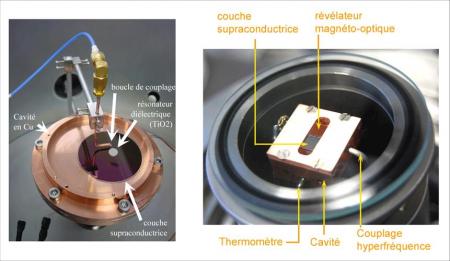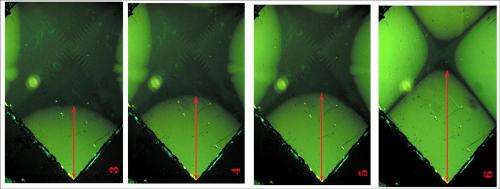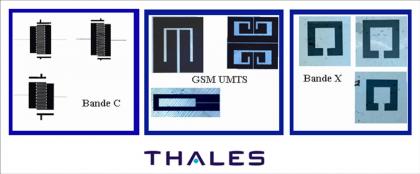


- J. Kermorvant, Laboratoire des Solides Irradiés & Unité Mixte CNRS-Thalès (Palaiseau)
- C.J. van der Beek, Laboratoire des Solides Irradiés, Ecole Polytechnique
- Collaboration J. Briatico, B. Marcilhac, J.C Mage, Unité Mixte CNRS-Thalès (Palaiseau), ANR Blanc grant 07-1-193024 "SURF"
| The use of high temperature superconductors remains a critical challenge. For applications in telecommunications, it is shown here that Joule heating is responsible for the deteriorated performance of superconducting devices for high microwave power [1]. Several tracks are proposed to eliminate this undesirable effect. |
Many applications have been considered for high superconducting critical temperature (SHTC, like YBa2Cu3O7) which solve the problem of the very low temperatures necessary for the use of conventional superconductors. Among these, for telecommunication technologies, superconducting YBa2Cu3O7 thin layers can realize bandpass filters of very high quality factor Q. It would thus become possible to reduce the bandwidth allocated to each channel to better meet the needs in information transmission in the Band 10 - 100 GHz.
However, the non-linear response to the high microwave power required for telecommunications is the major source of degradation of the signal, for which various causes have been proposed:
- The high frequency makes easier the excitation of the electrons in states where the electrical resistance is no longer zero. This effect is even more important for SHTC because of the non-spherical symmetry of their ground state [2].
- The screening current induced by a powerful electromagnetic field disrupts the vortex structure [4], allowing the penetration of the magnetic flux and hysteresis losses.
- The global or local warming of the material, because of very small periodic excursions of quasiparticles (unpaired electrons) or vortices induced by the microwave field.

Devices for measuring the surface resistance at the "Unité Mixte de Physique CNRS-Thalès" (left) and the "Laboratoire des Solides Irradiés " (right). The latter allows in-situ visualization of the distribution of magnetic field by means of a magneto-optical indicator.
A comprehensive study jointly driven by the Laboratoire des Solides Irradiés and the "Unité Mixte CNRS Thalès", shows that the nonlinearities measured are exclusively due to Joule heating of the layers and that the disruption of the vortices (hysteresis losses ) is not necessarily involved [1]. Measurements were made by measuring the resonant frequency (~ 10 GHz) of dielectric resonators designed to concentrate the microwave field within the superconductor. Measuring the frequency may indeed be directly related to the temperature, making so a local temperature sensor.
These observations open new strategies being explored for the improvement of superconducting devices used in the microwave band. The negative effect of vortex fluctuations at the nanoscale can be blocked by a shield device coupled with the introduction of micro-(or nano-) holes in YBa2Cu3O7 by chemical or electronic lithography. This avoids the presence of vortices, and the rare present vortices will be trapped by these holes replacing the heart. This completely eliminates the localized states of quasi-particles associated with vortices (but not the itinerant states, resulting from an intrinsic property of the material).
It becomes also possible to use in the next future thin layers of new superconductors based on iron pnictides (As, P... compounds). Superconductors of this type have in fact the great advantage of a spherical wave function, without excitation of quasi-particles at low temperature, and can be used at temperatures between 20 to 30 K, accessible to most closed cycle cryo-coolers.
References :
[1] Joule heating and high frequency nonlinear effects in the surface impedance of high Tc superconductors,
J. Kermorvant, C.J. van der Beek, J.-C Mage, B. Marcilhac, Y. Lemaître, J. Briatico, R. Bernard, J. Villegas, J. Appl. Phys. 106, 023912 (2009).
[2] Pairing symmetry in cuprate superconductors,
C.C. Tsuei et J.R. Kirtley, Rev. Mod. Phys. 72, 969 (2000).
[3] Strong pinning in high-temperature superconducting films,
C.J. van der Beek, M.V. Indenbom, M. Konczykowski, A. Abal'oshev, I. Abal'osheva, P. Gierlowski, S.J. Lewandowski, et S. Barbanera, Phys. Rev. B 66, 024523 (2002).
[4] Linear and nonlinear ac response in the superconducting mixed state,
C.J. van der Beek, V.B. Geshkenbein, et V.M. Vinokur, Phys. Rev. B 48, 3393 (1993).

Magneto optical imaging of the penetration of a static magnetic field, induced by the increasing power of the microwave field in a YBa2Cu3O7 layer (T = 72 K). The green light areas are penetrated by the magnetic flux, that is to say, by vortices. The green light areas are penetrated by the magnetic flux, that is to say, by vortices. The extension of the dark area in the center, free of vortices, shrinks with the amplitude of the microwave field.













